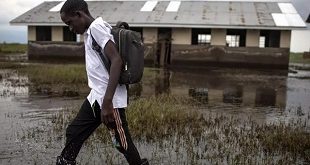
By Mahmood Mamdani
In this four-part series, renowned Ugandan scholar Professor Mahmood Mamdani examines the historical causes of Zimbabwe’s crisis
What land reform has meant or may come to mean for Zimbabwe’s economy is still hotly disputed. Recently there have been signs that scholarly opinion is shifting. A study by Ian Scoones of Sussex University’s Institute of Development Studies ‘” in collaboration with the Programme for Land and Agrarian Studies (PLAAS) at the University of the Western Cape ‘” challenges some of the conventional wisdom in media and academic circles within and beyond Zimbabwe.
The problem with this wisdom is that certain highly destructive aspects of reform ‘” coercion; corruption and incompetence; cronyism in the redistribution of land; lack of funds and an absence of agricultural activity ‘” have come to stand for the whole process. In particular, Scoones identifies five myths: that land reform has been a total failure; that its beneficiaries have been largely political cronies; that there is no new investment in the new settlements; that agriculture is in ruins; and that the rural economy has collapsed. Researchers at PLAAS have been quick to point out that over the past eight years small-scale farmers ‘have been particularly robust in weathering Zimbabwe’s political and economic turmoil, as well as drought’. Ben Cousins, the director of PLAAS and one of the most astute South African analysts of agrarian change ‘” who had previously argued that the land reform would destroy agricultural production ‘” now says that the future of Zimbabwe lies in providing small farmers with subsidies so that food security can be achieved. According to researchers at the African Institute for Agrarian Studies in Harare, new farms need to receive subsidised maize seed and fertiliser for a few seasons before achieving full production. Some might give up during this period, but not many ‘” partly because the land tenure system doesn’t allow land sales; only land permits or leases can be acquired.

Zimbabwe has seen the greatest transfer of property in southern Africa since colonisation and it has all happened extremely rapidly. Eighty per cent of the 4000 white farmers were expropriated; most of them stayed in Zimbabwe. Redistribution revolutionised property-holding, adding more than a hundred thousand small owners to the base of the property pyramid. In social and economic ‘” if not political ‘” terms, this was a democratic revolution. But there was a heavy price to pay.
The first casualty was the rule of law, already tenuous by 1986. When international donors pressured the regime in the run-up to the parliamentary elections of 2000 by suspending aid and loans ‘” a boycott favoured by the MDC and the unions ‘” the government simply fixed the result in its favour. In the violence that followed, more than a hundred people died, including six white farmers and 11 black farm labourers. Some of the violence was government-sponsored and most of it state-sanctioned. The judiciary was reshaped, local institutions in rural areas narrowly politicised, and laws were passed which granted local agencies the powers necessary to crush opponents of land reform. Denouncing his adversaries in the trade unions and NGOs as servants of the old white ruling class, Mugabe authorised the militias and state security agencies to hound down opposition, as repression and reform went hand in hand. In 2003, the leading independent newspaper, the Daily News, was shut down. While jubilant government supporters applauded the sweep of the revolution in agrarian areas, the opposition denounced the repression that accompanied it. Land reform had been ruthless, but in 2004, the violence began to abate. There was noticeably less violence surrounding the parliamentary elections of 2005.
In retrospect, it is striking how little turmoil accompanied this massive social change. The explanation lies in the participation of key rural figures in ad hoc but officially sanctioned land committees. When first introduced in 1996, these committees had mixed fortunes, some not functioning at all, others becoming instruments of this or that group of squatters. But a radical change occurred in 2000, when the committees were expanded to include centrally appointed security officials, ruling party representatives and local government personnel, as well as local veterans and traditional leaders. Charged with implementing fast-track land reform, these committees sidelined the old local administrative structures. They also had a national impact, since they reported to similarly constituted provincial committees, which in turn reported to the Ministry of Local Government. It was the infusion of veterans that gave the new semi-bureaucratic committees the edge over their wholly bureaucratic counterparts. Local committees usually comprised between 15 and 30 members. The veterans formed ‘base camps’ represented by ‘committees of seven’ which took the lead in identifying land for acquisition as well as finding prospective beneficiaries (mostly from veterans’ waiting lists and rosters in former ‘communal areas’). They also judged disputes, punished petty criminals and allocated farm equipment, seeds and so on. In a word, the committees co-ordinated everything, thus constituting new centres of power.
The second casualty of the reform was farm labourers. There were about 300,000 in all, around half of them part-time. Fast-track reform resulted in a massive displacement of these workers, who were traditionally drawn from migrant labour. Nearly a fifth came from neighbouring states and were regarded with suspicion by peasants in communal areas; even if they’d been born locally, they were often seen as foreigners and denied citizenship rights. Migrants and women (many employed as casual labour) were the weakest links in the rural mobilisation for land reform. Many were thought to have been encouraged by landowners to vote against the government’s constitutional proposals, and the anti-land-reform lobby certainly tried to organise farm workers, ostensibly to protect their jobs, but really to protect the white ownership of farms. When the workers rallied by the MDC, civil society activists and white farmers clashed with veteran-led occupiers, they came off badly. Occupiers held meetings to explain to workers what was at stake and eventually came themselves to distinguish between white farms, not only on the basis of size, proximity to communal areas, and the amount of unused land, but also on the basis of the farmer’s attitudes, particularly on race and towards his workers, and whether he had participated in the counter-insurgency during the independence struggle.
Some of the 150,000 full-time farm workers threw in their lot with the occupiers, though usually not on the farms where they had been employed. About 90,000 kept their jobs on sugar and tea estates, and on new or already established tobacco and horticulture farms. About 8000 were granted land, but most were denied it on the grounds that they or their elders had come from foreign countries, though some were given citizenship. Many went from steady employment to contract or casual work; many others were forced to supplement their meagre incomes through fishing, petty trading, theft and prostitution.
The best publicised casualties of the land reform movement were the urban poor who hoped to benefit from extending land invasions to urban areas. The veterans spearheaded occupations of urban residential land in 2000-1. Housing co-operatives and other associations followed their lead and set up ‘illegal’ residential or business sites. But the state feared that it would lose control over towns to the MDC if the land reform movement was allowed to spread and met these occupations with stiff repression, including Operation Restore Order/ Murambatsvina, a surprise military-style intervention in 2005 in which tens of thousands of families were evicted. Not surprisingly, those who opposed land reform in rural areas were the strongest critics of government efforts to stifle occupations in urban areas.
The final casualty was food production: Zimbabwe, once a food surplus country, is today deficient in both foreign exchange and food. In 2002-3, half the population depended on food aid: this was a drought year and the figures improved in 2004-5. The UN now estimates that nearly half the country’s 13.3 million inhabitants will once again be dependent on food aid in 2009, after another drought year. A million of these are poor, urban residents who can’t afford imported food. The rest are peasants, most of them hit by drought. Climate change is clearly a factor here, its role most obvious in marginal land: the communal areas worked by millions of small farmers. A 2002 World Food Programme study noted that there had been three droughts in Zimbabwe since 1982 and that the 2002 drought, which also affected several neighbouring countries in Southern Africa, was the worst in 20 years. The WFP estimated that 12.8 million people in the region would require assistance as a result of that drought and that in Zimbabwe alone, overall production would decline by 25 per cent, with cereal production down 57 per cent and maize, the staple in the diet of ordinary Zimbabweans, down by a devastating two-thirds.
To separate out the effect of drought and that of reform ‘” and thus to understand how land reform has hit production ‘” one needs first to distinguish between three groups of agricultural producer: local white farmers, who were the target of the land reform; peasants with farms in communal areas; and foreign corporations, whose large farms (except for small tracts of unused land) remain intact. Harry Oppenheimer, for example, lost most of his private land, but his firm, Anglo American, kept its sugar estates, which it then sold to Tongaat Hulett, a South African firm with 15,000 hectares in Zimbabwe. In a nutshell, white commercial farmers focused on export crops, whereas communal farmers were the major source of food security. The production of tobacco, hitherto the main source of foreign exchange, is concentrated in large-scale commercial farms; it has seen the most severe decline, almost entirely as a result of land reform. Maize and cotton are peasant crops and have not really been directly affected by land reform, but have suffered badly from prolonged drought ‘” maize production was down by 90 per cent between 2000 and 2003. In contrast, the production of crops ‘” sugar, tea, coffee ‘” grown mainly by the large corporate plantations has remained steady.
Mahmood Mamdani is Herbert Lehman Professor of Government in the departments of anthropology, political science and international affairs at Columbia University. This article first appeared in the London Review of Books; it is published by The Independent with his permission.
 The Independent Uganda: You get the Truth we Pay the Price
The Independent Uganda: You get the Truth we Pay the Price


